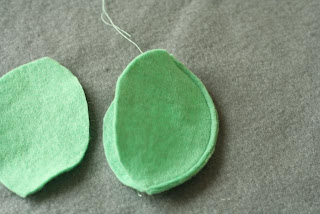Tutorial
Makes one strawberry (although given there are a number of steps it is much easier to make more than one at a time). Finished size - approx 4cm high & 4cm wide at the widest point.
Materials - red felt (10cm square), green felt, embroidery thread, thread, needle, sewing machine (optional), stuffing. A glass or small bowl with approx 9-10cm diameter works well to help draw the strawberry part-circle pattern.
 |
| Basic pattern shapes |
 |
| 6 sewn calyx/tops with one cut out ready to go |
Strawberry 'body' - From red felt cut one part-circle (roughly a semi-circle with about an extra 1/8th of a circle). Use 3 strands of pinky/brown embroidery thread (or a mix of these types of colours) to hand stitch seeds all over the red flesh of the strawberry.
Then fold right sides together and align straight edges. Machine stitch seam along straight edge. Clip excess felt away at the point if needed then turn right side out and make sure the point is poked out properly to give a nice shaped strawberry. Next, hand stitch a running stitch (using a double thread for extra strength) all the way around the top curved edge leaving a long tail of thread.
Then pull up the gathering thread carefully to begin to close the top of the strawberry. Before the opening gets too small though, stuff the hole with polyfill to fill the strawberry. A tip here is to first secure the end of the thread before you start the running stitch & then pull & gather up the felt to close the opening - far less fiddly than having 2 free ends of thread to pull up to gather while also trying to fit stuffing into a small space. Once stuffed, pull the gathering threads to mostly close off the hole & tie off. Reinforce gather with another round of stitching.
Finally, sew on the green calyx / top & you have one completed strawberry.
Just a few more to make a punnet!
Other felt food:
Link to my felt apple entry












































